Something Meaningful | Abuse of Older People (AOP) Awareness Day – 15 June
World Elder Abuse Awareness Day was created by the International Network for the Prevention of Elder Abuse in 2006 and recognised by the United Nations (UN) in 2011. Celebrated annually on the 15th of June, it is an opportunity to educate and bring awareness to the often silent but prevalent issue of abuse and neglect among the older members in our communities.
Global statistics project that by the mid-2030s, the number of those aged 60 years and above will grow by 38%. In New Zealand, it is predicted that during the 2030s, individuals aged 65+ will account for more than 20% of the population while individuals aged 85+ is predicted to increase from 1 in 50 people to 1 in 30. With this projected increase in the older population, it is more important than ever to understand and address abuse among older people. World Health Organization defines abuse of older people as intentional or unintentional act(s) or inaction occurring within trusted relationships and results in the older person being harmed or distressed.
Abuse of older people is a violation of human rights and can include psychological, financial, physical, and sexual abuse and neglect. Ageism is considered the underlying issue behind abuse of older people leading to lowered physical and mental health, and poorer quality of life. Ageism is a social and cultural construct that influences thoughts, emotions and behaviours and lead to discrimination towards self and others based on age. Ageism can lead to abuse being justified and impose a barrier to appropriate policy and service development.
Statistics provided by Age Concern New Zealand indicate prevalence of the different types of abuse in New Zealand are: 85% psychological, 31% financial, 25% physical, 16% self-neglect, 10% neglect, 2% institutional and 1% sexual. More than one type of abuse is present in most reported cases. 75% of alleged abusers are family members, with 50% of that being adult children or grandchildren and 43% living in the same household as the older person. While older females are slightly more likely to experience abuse, alleged abusers are as likely to be females as males.
While there is generally a cultural expectation in culturally and linguistically diverse (CALD) communities for older people to be respected, valued and taken care of; abuse of older people is prevalent within these population groups, with 7% of reported cases in New Zealand being from Asian, Middle Eastern, African and Latin American communities. While research in New Zealand is scarce, Australian research has found that being of CALD background populations increases the probability of experiencing abuse as an older person.
Intergenerational conflict, language barriers, social isolation and limited access to services have been found to be the biggest risk factors among CALD older people. Intergenerational differences in cultural norms and expectations can lead to conflict and put older CALD populations at greater risk of abuse. Older people with limited English proficiency are more vulnerable to financial control and social isolation as they are reliant on their adult children and/or grandchildren to communicate, access services and make social connections. Institutional abuse in the form of cultural insensitivity in assessments, care plans and service provisions in aged care services, residential care facilities, and hospitals can bring significant anxiety and distress as well as delay or prevent access to required care. Lack of easy access to professional interpreting services for service providers is also a form of institutional abuse.
While there has been an increase in reporting of older abuse over recent years, stats indicate that 75% of abuse in New Zealand are unreported. In older CALD populations, there is often a hesitance to report due to fear of straining family relationships, becoming homelessness, and bringing social stigma and shame to the family. There may also be a lack of awareness or different interpretations of the concept of abuse of older people which may mean neither the one being harmed, nor the one causing harm realise what is occurring is considered abuse. Some studies in Australia have shown that once the concept is explained, there was an increase in reported cases among CALD populations.
It is thus important that approaches to assessing and addressing abuse among older CALD populations are placed and understood within the wider social context and considered alongside culturally and individually specific risk factors. Practitioners need to be aware of their own attitudes and perceptions. They require cultural humility and skills in cross-cultural practice as well as skills to understand and advocate around institutional or systemic barriers.
Special thanks to Age Concern for providing statistics and insight.
Please visit ageconcern.org.nz and officeforseniors.govt.nz for more information and resources.
Contributed by Dulani Abeysinghe, eCALD® Educator, Health New Zealand | Te Whatu Ora
